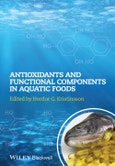Antioxidants and Functional Components in Aquatic Foods will be of great interest to the food science, medical, biochemical and pharmaceutical fields for professionals who deal with aquatic food products, muscle foods products (beef, pork, poultry etc), lipid oxidation, and pro-oxidant and antioxidant systems.
Table of Contents
List of contributors ix
Preface xi
1 Oxidation in aquatic foods and analysis methods 1
Magnea G. Karlsdottir, Holly T. Petty , and Hordur G. Kristinsson
1.1 Introduction 1
1.2 Analysis of lipid oxidation 2
1.3 Conclusions 16
References 16
2 Protein oxidation in aquatic foods 23
Caroline P. Baron
2.1 Introduction 23
2.2 Mechanisms involved in protein oxidation 24
2.3 Impact of protein oxidation on aquatic food 30
2.4 Case studies 33
2.5 Conclusions and perspectives 38
References 38
3 Influence of processing on lipids and lipid oxidation in aquatic foods 43
Sivakumar Raghavan and Hordur G. Kristinsson
3.1 Effect of freezing on lipid oxidation 43
3.2 Effect of salting and drying on lipid oxidation 49
3.3 Effect of fermentation on lipid oxidation 53
3.4 Effect of smoking on lipid oxidation 55
3.5 Effect of high-pressure processing on lipid oxidation 58
3.6 Effect of irradiation on lipid oxidation 61
3.7 Effect of microwave processing on lipid oxidation 63
3.8 Effect of modified atmosphere on lipid oxidation 65
3.9 Effect of pH shift extraction method on lipid oxidatio 67
3.10 Effect of canning on lipid oxidation 70
References 73
4 Strategies to minimize lipid oxidation of aquatic food products post harvest 95
Huynh Nguyen Duy Bao and Toshiaki Ohshima
4.1 Introduction 95
4.2 Lipid oxidation and quality deterioration in post-harvest aquatic food products 96
4.3 Post-harvest control of oxidative deterioration in aquatic food products 106
4.4 Conclusions and prospects 117
References 118
5 Antioxidative strategies to minimize oxidation in formulated food systems containing fish oils and omega-3 fatty acids 127
Charlotte Jacobsen, Anna Frisenfeldt Horn, Ann-Dorit Moltke Sørensen, K. H. Sabeena Farvin, and Nina Skall Nielsen
5.1 Introduction 127
5.2 The lipid oxidation process 128
5.3 Factors affecting lipid oxidation in omega-3-enriched foods 129
5.4 Introduction to antioxidants 131
5.5 Antioxidant effects in different omega-3-enriched food products 132
5.6 Other strategies to protect omega-3 products against oxidation 145
5.7 Conclusions 145
References 146
6 Methods for assessing the antioxidative activity of aquatic food compounds 151
Holmfridur Sveinsdottir, Patricia Y. Hamaguchi, Hilma Eidsdottir Bakken, and Hordur G. Kristinsson
6.1 Background 151
6.2 Oxidation and antioxidants 153
6.3 Methods for determining antioxidant activity 157
References 169
7 Influence of fish consumption and some of its individual constituents on oxidative stress in cells, animals, and humans 175
Britt Gabrielsson, Niklas Andersson, and Ingrid Undeland
7.1 Introduction 175
7.2 What is oxidative stress? 176
7.3 Why is oxidative stress of importance and how does it link to diet? 177
7.4 How is oxidative stress measured? 178
7.6 Effects of fish intake on biomarkers used to evaluate oxidative stress 195
7.7 Methodological considerations 200
7.8 Conclusion and need for future studies 202
References 204
8 Marine antioxidants: polyphenols and carotenoids from algae 219
Kazuo Miyashita
8.1 Introduction 219
8.2 Chain-breaking antioxidants 220
8.3 Antioxidants and their beneficial health effects 221
8.4 Seaweeds as a rich source of antioxidants 222
8.5 Algal polyphenols 222
8.6 Marine carotenoids 224
8.7 Antioxidant activity of carotenoids 225
8.8 Astaxanthin and fucoxanthin 226
8.9 Conclusions 228
References 229
9 Fish protein hydrolysates: production, bioactivities, and applications 237
Soottawat Benjakul, Suthasinee Yarnpakdee, Theeraphol Senphan, Sigrun M. Halldorsdottir, and Hordur G. Kristinsson
9.1 Introduction 237
9.2 Source of fish protein hydrolysates 238
9.3 Production of fish protein hydrolysate 241
9.4 Properties of hydrolysate 255
9.5 Applications of fish protein hydrolysates 263
References 266
10 Antioxidant properties of marine macroalgae 283
Tao Wang, Rosa Jonsdottir, Gudrun Olafsdottir, and Hordur G. Kristinsson
10.1 Introduction 283
10.2 Antioxidant properties of algal polyphenols 284
10.3 Antioxidant activity of algal sulfated polysaccharides 298
10.4 Antioxidant activities of fucoxanthin 302
10.5 Antioxidant activities of sterols from marine algae 304
10.6 Antioxidant activities of peptides derived from marine algae 306
10.7 Antioxidant activity of mycosporine-like amino acids 307
10.8 Concluding remarks 310
References 311
Index 319








